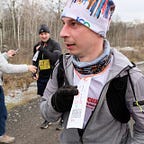Running with Rembrandt — “Leiden Marathon”
First of all, I want to say Thank you, because I appreciated my previous article was very impressed. Therefore, we are now transferring to the city of Leiden, which is in Holland.
Each road brings some of its own adjustments to the life of the one who strokes it.
Once, I had to go from Antwerp to Zielona Góra. Perhaps every person would walk in an easy way: by bus to Berlin, and then to Poland. But that is not for me. Anyone who likes to run would probably have done like me: firstly, when planning a road, it is necessary to check whether there is any race time on the way.
After a brief search on Google, I found what was needed — it was the Leiden Marathon. Why did it immediately feel so ideal for me? Because quite close to Leiden, in just 30 minutes, lives my university friend. It is always cool to have two nice things at one time, right?
Registration for the race (I chose a distance of 21 km) cost 60 euros. The price includes participation, a medal, and a T-shirt. In order to get to Leiden, I had to get to Rotterdam firstly, where I planned to transfer to the final point.
The Leiden Marathon has been taking place since 1991. Founded by Leiden Road Traffic Leaders Club, which first members received their first experience in the New York City Marathon. They were so impressed by the atmosphere and organization that they took the New York Marathon as an example and decided to organize their own. After that event, every year becomes more interesting and more extensive.
My way to the startup package began on May 26th. I had to get it in the old church at Pieterskerkhof. The package contained a small backpack, a number, and a T-shirt. Walking around the city a bit, I went to meet with a friend.
On the day of the race, it was Sunday, I woke up at 7, drank coffee and went to the station, where I was waiting for an electric train that had to bring me to Leiden. Already within it was the impression that this train, in addition to the participants of the race, no one goes. When I arrived, I started searching for a starting point: the task turned out to be too light because all the passengers were going there.
That’s the start place. I dressed and put my stuff in the storage chamber, and went to take my place directly at the start. The route partly lied through the streets of the city, and partly by the outskirts. Mostly it was flat, somewhere there were climbs and descents. The running process itself was not as complicated as I expected since the thermometer showed 24 degrees. Degradation stations were organized at distances of 5.5, 11, 15.5 and 18.4 km. In such a heat were very relevant sponges made from foam rubber, which were distributed throughout the road. In addition to conventional degradation stations, I met so-called “mobile” watering stations. The architecture of the Dutch houses and their inhabitants, who themselves watered the athletes with cold water, came to the aid. Sometimes it even seemed that everyone, from the smallest to the oldest citizen of the city, went to small porches to observe what was happening and to support the participants.
The finish was located near one of the many canals of the city. Near tracks participants were traditionally fed by delicious meals. In addition, you could relax after a tiring two-hour run, as well as take a photo.
Everything has its alpha and omega, the beginning and the end, the start and the finish, but my finish did not become an arch with the appropriate inscription. It was the train station and the train, where almost everyone was a runner, like me, where everyone was happy to go home.
